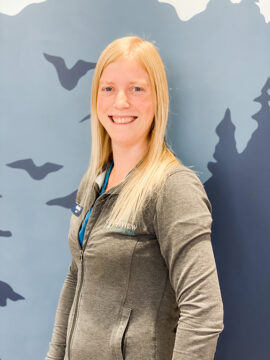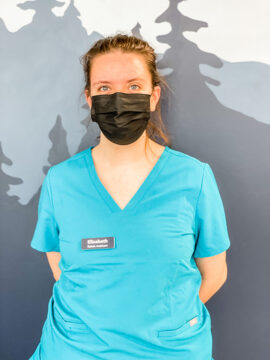The lack of dogs barking and cats meowing was the first thing I noticed when coming into the Cedarview Animal Hospital. I was expecting to see people bustling around trying to stay organized while taking care of animals. I was imagining the cages to be filled with pets while their owners waited their turn outside in the November cold.
Instead, I saw none of that.
“This is where we keep the dogs and cats that come in,” said Olivia Sparks, a Client Care Representative at the clinic. In front of me were two rows of three cages with light blue pieces of paper with the pet’s information, all empty. “The papers have names on them for Monday’s surgeries.” Today was Saturday.
Instead of a busy veterinary clinic, like I have seen many times whenever I would bring my own pets for a checkup before the pandemic, I saw a very clean clinic, no animals in the cages, the workers talking about the upcoming patients and one client arriving every hour.
They came in with their pets on a leash or in a crate. One of the workers would ask them the standard COVID-19 questions: Are you feeling any COVID-19 symptoms? Fever, cough, shortness of breath? Have you been in close proximity to someone who has tested positive for COVID-19? Have you travelled outside of Canada recently?
Only after they sanitized their hands could the client leave the cold and enter the clinic to be served.
Everything was organized and quiet. Nothing of what I imagined a shortage of veterinarians to look like.
Located in Cedarview Square in Nepean, Ontario, the Cedarview Animal Hospital is owned by Nigel Gumley, 60, who has been running the clinic for 12 years.
“Vet shortages are a really tough thing to deal with for sure,” says Sparks. “We’ve been dealing with a lot of extra clients coming along, there is also a lot of extra puppies and dogs and kitties.”

Olivia Sparks is the Client Care Representative at the clinic. Photo credit: Provided by the Cedarview Animal Hospital
When talking about the lack of veterinarians she mentions, “Basically, there is nowhere for people to go when they get these new pets, and they really want to be able to come and see us. Unfortunately, with the number of vets that we have and the services we can provide with being able to provide top health care for pets, we can only see a certain number per day.”
Spark’s husband, David Sparks, also studied in the veterinary field. He says there are about 120 students in his classes. “And each year, they can only pass so many in each of the veterinary schools that they have in Canada,” says Olivia Sparks. “It’s really tough to be able to alter that number without the funding to increase the number of students.”
For a person to become a veterinarian they must choose between the Ontario Veterinary College (OVC), Atlantic Veterinary College (AVC), Faculty of Veterinary Medicine, Université de Montréal, Western College of Veterinary Medicine (WCVM), and Faculty of Veterinary Medicine, University of Calgary-the five veterinary colleges in Canada.
“It is estimated that they [the veterinary colleges] put out three and a half per cent of the veterinary population,” said Gumley. “When I say three and a half per cent, we’re looking at replacing that number of vets each year. That has already been less than the number of people leaving.”
Like all jobs, people come and go every year, whether it be retirement or to a different job. The baby boomers, now starting to retire, have been the generation with the most people of working age. And with all of them leaving almost at the same time, it is leaving a big gap in taken jobs.
“So, we were already facing a shortage before we came into the pandemic. However, now what we are finding is what we actually need closer to five per cent.”
To make this bleaker, Gumley does not believe there will be a rise in veterinary graduates in the coming years.
Each graduate must go through six years at the college. Two years of pre-veterinary courses and four years of specialized education. Students must attend classes that include but are not limited to anatomy, biochemistry, physiology, and toxicology.
Gumley explains that if the government were to add 10 extra seats for students within the college – which he believes is still not enough to fix the shortage – it would still take six years for those students to graduate and find a job in the same field.
Kristin Emslie, a 35-year-old Registered Veterinary Technician, says that the Cedarview Animal Hospital is well equipped and staffed considering the ongoing vet shortage but there are still some restrictions.

Kristin Emslie is the Registered Veterinary Technician at the clinic. Photo credit: Provided by the Cedarview Animal Hospital
“We have full days, every day, with appointments. We can only allot a certain amount of emergency spots per day with the vets that we have. We do have a very good staff, but I know other clinics are suffering.”
She also reiterates Dr. Gumley’s point. “Vet schools are not producing the amount students that used to be graduating. So, there is a North American shortage.”
Emslie reminds clients to be patient with them “since there has been a huge global influx in pets. There are now more pets and clients than there is veterinary staff. It makes it very hard as an industry because we want to keep up and we want to do what’s best for your pet. But sometimes we just don’t have the manpower.”
Emslie is not sure whether there will be a rise in veterinarians in the coming year. “There is a very large side of the veterinary field with mental health issues, due to the pandemic. There is such a demand from pet owners for services because there are so few veterinary staff to support it. It’s a huge burden on people’s mental health.”
A study from the American Veterinary Medical Association published a study on the mental health of Canadian veterinarians in 2020. After surveying over 1400 Canadian veterinarians, results showed that compared to the general population, they had a higher score in burnouts, anxiety, and depression.
“The 12-month prevalence of suicidal ideation for participants was 26.2 per cent,” the study wrote. “Which was substantially higher than the estimated prevalence for the general international population (2.1 per cent to 10.0 per cent).”
Elizabeth Scherf, a 27-year-old Rehabilitation Assistant, worked at an Emergency Veterinary Medicine during the veterinary shortage.

Elizabeth Scherf is a Rehabilitation Assistant attached to the clinic. Photo credit: Provided by the Cedarview Animal Hospital
“When I used to work in emergency, it was a lot harder because when there are not enough vets and everything was closing down. So, that was very hard. We were doing the best we could, but it was still as though we were trying to catch up.”
Scherf thanks the people studying to become a veterinarian. “We really need vets,” she says. “It’s a really important job. It’s a lot of work but if you find the thing you are passionate about and you work in that field.
“The veterinary field is so diverse and huge, there are so many different avenues you can go into. Burnout is a real thing but if you’re taking it one step at a time it’s going to be an amazing experience.”



